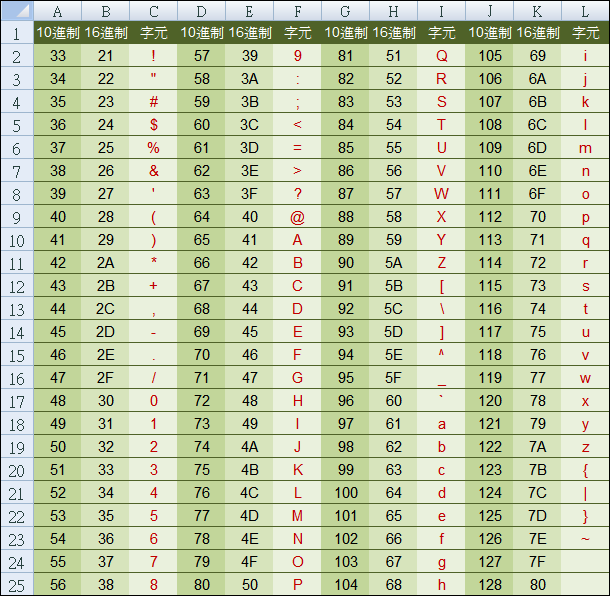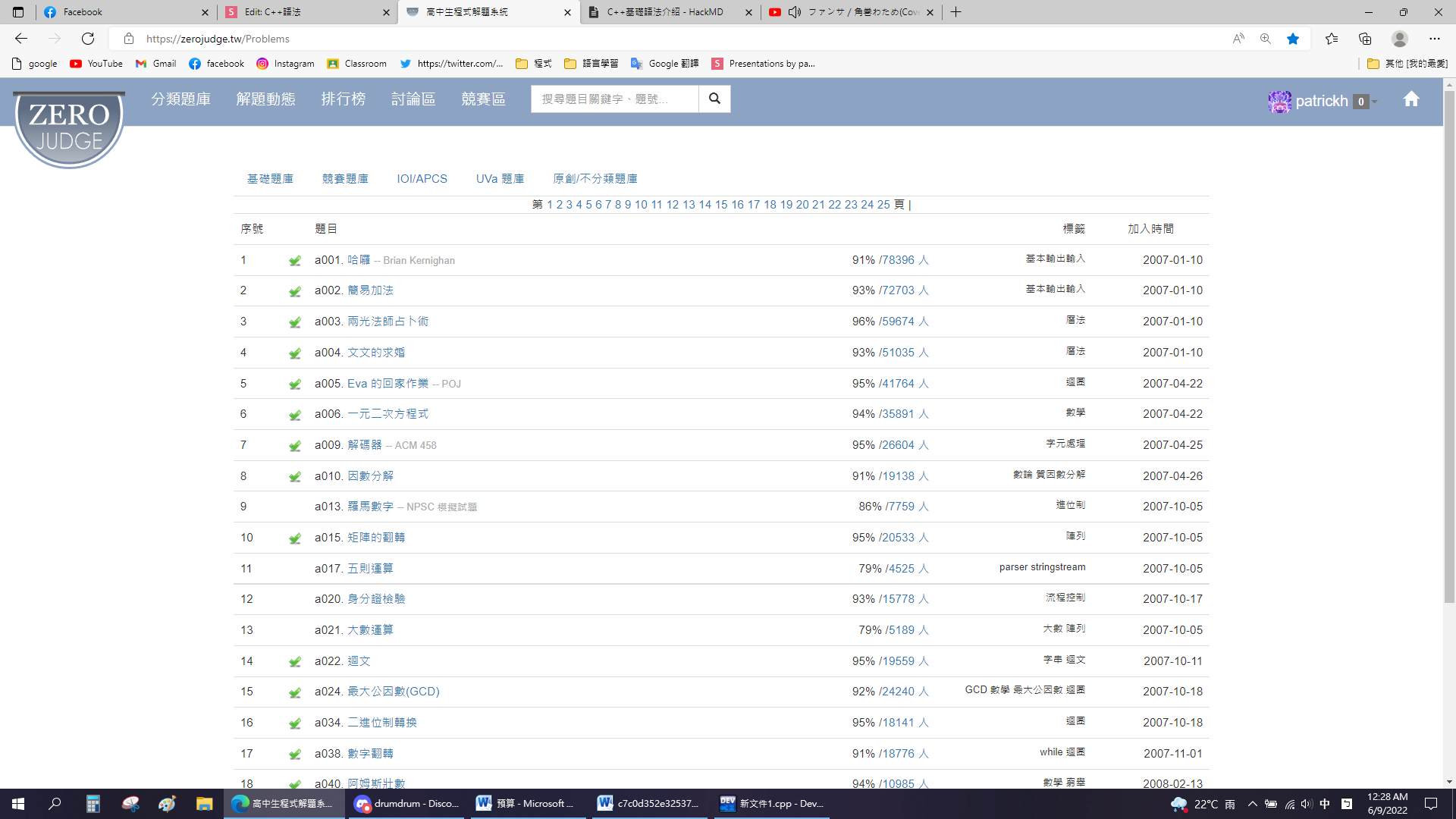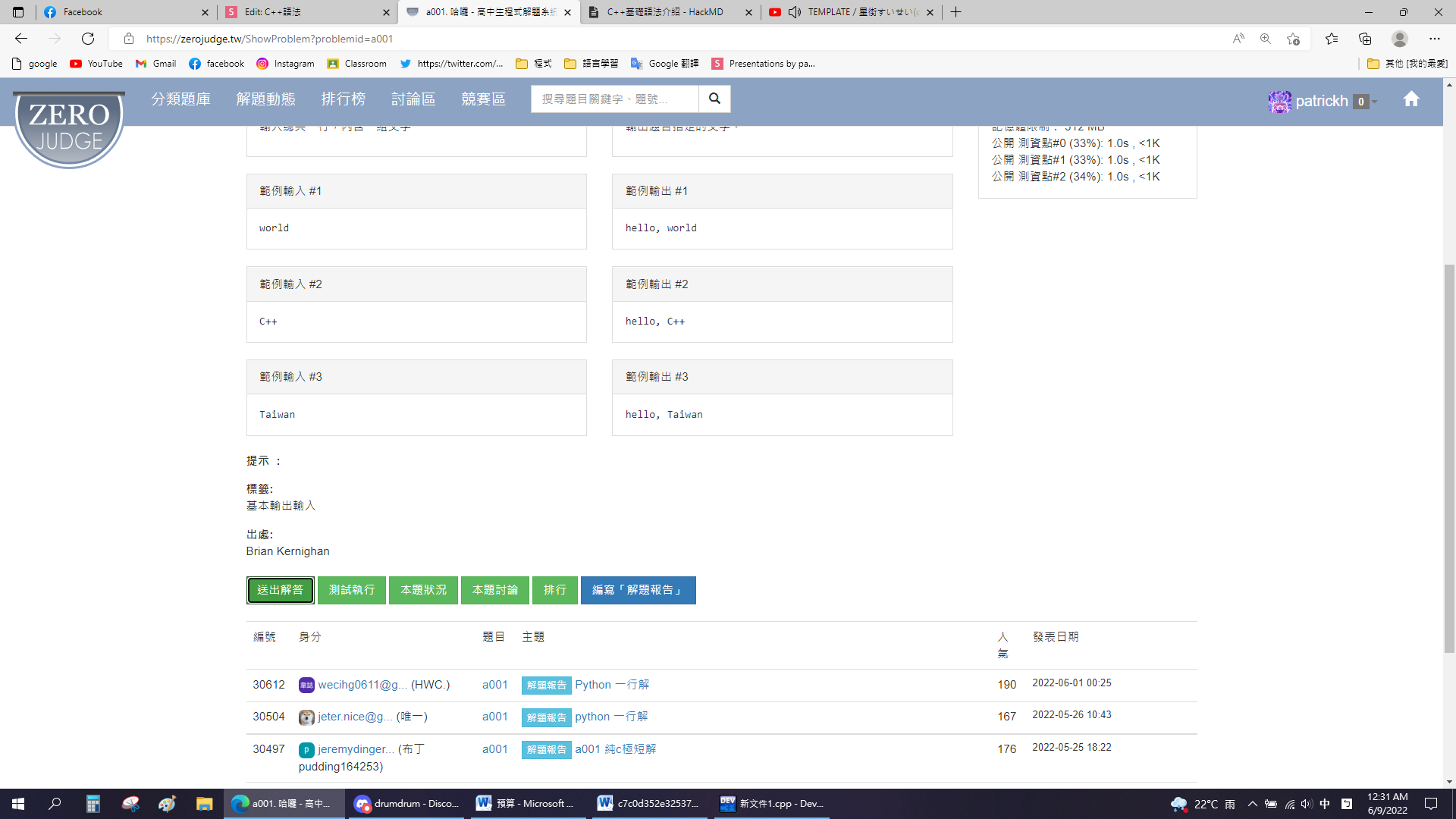C++語法
Hello world!
#include <iostream>
using namespace std;
int main() {
cout << "Hello world!" << endl;
}
初始程式碼
#include <iostream>
代表引入一個函式庫,裡面是別人寫好的各種函式
iostream是輸出輸入的函式庫
using namespace std;
代表引入一個命名空間
能區分不同函式庫的函式
例如原本的cout應該要寫成std::cout
使用using namespace std;後就只要cout就好
#include <iostream>
int main() {
std::cout << "Hello world!" << std::endl;
}
int main(){ }
代表主程式
大括號內的程式碼就是會執行的部分
cout << "Hello world!" << endl;
cout代表輸出的指令
endl代表換行
大部分程式碼結尾都要記得加;
後面會仔細講到輸入and輸出
萬用函式庫
能直接引入所有你會需要的函式
#include <bits/stdc++.h>
using namespace std;
int main() {
cout << "Hello World!";
}

變數
變數像是一個存放資料的東西,可以進行運算或處理
每個變數都需要先宣告才能使用
宣告變數
先打變數型態,空格後打變數名稱
例如: int a;
代表宣告一個型態是整數,名稱是a的變數
也能在宣告時給變數初始值
例如: int a = 10;
#include <iostream>
using namespace std;
int main() {
int a = 10;
cout << a;
}
宣告變數規則
- 不能以數字、符號(除了底線_)開頭
- 不能將變數命名為關鍵字(int、namespace...)
資料型態
整數
- int(-2^31 ~ 2^31-1)
- unsigned int(0 ~ 2^32-1)
- long long(-2^63 ~ 2^63-1)
- unsigned long long(0 ~ 2^64-1)
#include <iostream>
using namespace std;
int main() {
int a = 10;
long long b = 10;
}
浮點數(小數)
- float(小數點後7位)
- double(小數點後15位)
#include <iostream>
using namespace std;
int main() {
float a = 0.1;
double b = 0.1;
}
字元
- char(字元,以ASCII碼儲存,用' '表示)
- string(字串(字元陣列),用" "表示)
#include <iostream>
using namespace std;
int main() {
char a = 'a';
string b = "abcdef";
}

ASCII碼
布林值
- bool(true跟false)
#include <iostream>
using namespace std;
int main() {
bool a = true;
}
輸入and輸出
cin
賦予變數值,用法如下
cin >> 變數 >> 變數;
有幾個變數就打幾次
#include <iostream>
using namespace std;
int main() {
int a;
float b;
char c;
cin >> a >> b >> c;
}
cout
在螢幕顯示物件,可以是變數或數值
可以在最後加endl或'\n'換行,用法如下
#include <iostream>
using namespace std;
int main() {
int a = 10;
cout << "a = " << a << endl;
cout << 100 << '+' << 0.5 << '\n';
}
輸入輸出優化
增加cin、cout的效率
注意不能跟printf、scanf混用
#include <iostream>
using namespace std;
int main() {
ios::sync_with_stdio(0);
cin.tie(0);
cout.tie(0);
}

運算子
可以對變數或數值進行運算
指定運算子
直接將等號右邊的數值或運算結果賦予給變數
和數學的等於不同
#include <iostream>
using namespace std;
int main() {
int a;
a = 10 + 5; //a是15
}
算術運算子
加(+)
加就對了
#include <iostream>
using namespace std;
int main() {
int a = 5 + 3;
}
算術運算子
減(-)
減就對了
#include <iostream>
using namespace std;
int main() {
int a = 8 - 2;
}
算術運算子
乘(*)
乘就對了
#include <iostream>
using namespace std;
int main() {
int a = 4 * 7;
}
算術運算子
除(/)
當兩邊都是整數,小數點後會被無條件捨去
當其中一邊為浮點數,結果才會是浮點數
#include <iostream>
using namespace std;
int main() {
int a = 5 / 2; //2
float b = 5 / 2.0; //2.5
}
算術運算子
簡易改值(?
在指定運算子前方加上算術運算子
省略一次變數的名字
#include <iostream>
using namespace std;
int main() {
int a = 5, b = 5;
a = a + 2;
cout << a << '\n';
b += 2;
cout << b << '\n';
}
算術運算子
遞增(++)
將變數放在運算子前後會有不同效果
放前面的值為運算前的值
後後面為運算後的值
#include <iostream>
using namespace std;
int main() {
int a = 1;
cout << a++ << '\n'; //輸出1,a變為2
int b = 1;
cout << ++b << '\n'; //輸出2,b變為2
int c = 1;
c++; //c變為2
}
可單獨使用
算術運算子
遞減(--)
和遞增規則相同
#include <iostream>
using namespace std;
int main() {
int a = 1;
cout << a-- << '\n'; //輸出1,a變為0
int b = 1;
cout << --b << '\n'; //輸出0,b變為0
int c = 1;
c--; //c變為0
}
算術運算子
括號( () )
c++的計算皆符合四則運算
不分大,中,小括號
一律都使用小括號
#include <iostream>
using namespace std;
int main() {
int a = 20 / (2 * (4 + 1));
}
算術運算子
模、取餘數(%)
取就對了
#include <iostream>
using namespace std;
int main() {
int a = 8 % 3; //a為2
}
比較運算子
可以對數值或變數進行比較運算,會回傳布林值
- >(大於)
- <(小於)
- ==(等於)
- !=(不等於)
- >=(大於等於)
- <=(小於等於)
注意==和=不要搞混
一個是相等,一個是指定運算子
邏輯運算子
可以對布林值進行邏輯運算,會回傳布林值
- &&(and)
- ||(or)
- !(not)
&&(and)
當兩邊的布林值都是true(真)
結果才會是true
換句話說
其它結果都是false(假)
*小提醒
非0即為真
||(or)
當兩邊的布林值其中一個是true
結果便會是true
換句話說
當兩邊都為false
結果才會是false
!(not)
只會對一個值作用
將布林值相反
true -> false
false -> true

邏輯運算
例題
if else if-else
用條件讓電腦判斷要執行的程式碼
if
會有一個判斷條件,條件達成會執行大括號內的程式
if的格式如下
#include <iostream>
using namespace std;
int main() {
// if(判斷條件){
// 條件達成時會執行的程式
// }
int a = 5;
if(a > 1){
cout << "a大於1";
}
}
else
如果if的條件都沒達成,就會執行大括號內的程式
else的格式如下
#include <iostream>
using namespace std;
int main() {
// if(判斷條件){
// 條件達成時會執行的程式
// }
// else{
// 條件都不達成會執行的程式
// }
int a = 5;
if(a < 1){
cout << "a小於1";
}
else{
cout << "a不小於1";
}
}
else if
如果有多個條件要判斷時使用
else if的格式如下
#include <iostream>
using namespace std;
int main() {
// if(判斷條件){
// 條件達成時會執行的程式
// }
// else if(判斷條件){
// 條件達成時會執行的程式
// }
// else{
// 條件都不達成會執行的程式
// }
int a = 5;
if(a < 1){
cout << "a小於1";
}
else if(a > 10){
cout << "a大於10";
}
else{
cout << "a不小於1也不大於10";
}
}
小提醒
放較前面的if或else if如果達成了
後面的其他條件會被直接無視
例題:成績等第
在考完數學小考後,你想知道你的成績位於哪個等第
90分以上為A等第
80分以上為B等第
70分以上為C等第
其餘為D等第
#include <iostream>
using namespace std;
int main() {
int score;
cin >> score;
if(score >= 70)
cout << "C";
else if(score >= 80)
cout << "B";
else if(score >= 90)
cout << "A";
else
cout << "D";
}

由於70分以上的判斷放在最上面
因此無論是100、90分都會被歸類到C等第
解法1
將判斷順序調換
#include <iostream>
using namespace std;
int main() {
int score;
cin >> score;
if(score >= 90)
cout << "A";
else if(score >= 80)
cout << "B";
else if(score >= 70)
cout << "C";
else
cout << "D";
}
解法2
條件改嚴格一點
#include <iostream>
using namespace std;
int main() {
int score;
cin >> score;
if(score >= 70 && score < 80)
cout << "C";
else if(score >= 80 && score < 90)
cout << "B";
else if(score >= 90 && score <= 100)
cout << "A";
else
cout << "D";
}
例題
迴圈
讓電腦重複執行
for迴圈
通常在已知要重複幾次的狀況下使用
格式如下
#include <bits/stdc++.h>
using namespace std;
#define IO ios::sync_with_stdio(0);cin.tie(0);cout.tie(0);
typedef long long ll;
int main() {
// for(一開始要做的事; 執行條件; 跑完一圈後要執行的動作){
// 迴圈裡的程式;
// }
}
重複跑指定次數的寫法
一開始將i設定為0
執行條件為i < 次數
一圈結束後將i+1
#include <bits/stdc++.h>
using namespace std;
#define IO ios::sync_with_stdio(0);cin.tie(0);cout.tie(0);
typedef long long ll;
int main() {
// for(int i = 0; i < 執行次數; i++){
// 迴圈裡的程式;
// }
// 以下為範例
for(int i = 0; i < 3; i++){
cout << i << '\n';
}
}
while迴圈
通常在未知要重複幾次的狀況下使用
格式如下
#include <bits/stdc++.h>
using namespace std;
#define IO ios::sync_with_stdio(0);cin.tie(0);cout.tie(0);
typedef long long ll;
int main() {
// while(執行條件){
// 迴圈裡的程式;
// }
int a = 0;
while(a < 5){
cout << a << '\n';
a++;
}
}
do while迴圈
和while迴圈很類似
但會無視條件先跑第一圈
也就是說
即使條件未達成,也會執行1次
格式如下
#include <bits/stdc++.h>
using namespace std;
#define IO ios::sync_with_stdio(0);cin.tie(0);cout.tie(0);
typedef long long ll;
int main() {
// do{
// 迴圈裡的程式;
// }while(執行條件);
int a = 0;
do{
cout << a << '\n';
a++;
}while(a > 10);
}
break
直接結束整個迴圈
#include <iostream>
using namespace std;
int main() {
for(int i = 0; i <= 10; i++){
if(i == 5)
break;
cout << i << " ";
}
}
continue
直接進入下一圈
#include <iostream>
using namespace std;
int main() {
for(int i = 0; i <= 10; i++){
if(i == 5)
continue;
cout << i << " ";
}
}
巢狀迴圈
很多層迴圈
記得for迴圈的變數名稱不要重複
#include <iostream>
using namespace std;
int main() {
for(int i = 1; i <= 9; i++){
for(int j = 1; j <= 9; j++){
cout << i << " * " << j << " = " << i * j << '\n';
}
cout << '\n';
}
}
因為我沒梗了所以放九九乘法表
多筆輸入(輸入直到EOF)
#include <iostream>
using namespace std;
int main() {
int a;
while(cin >> a){
cout << a * a << '\n';
}
}
無限輸入
例題
解題系統
刷題的網站
有很多題目可以練習
只要辦一個帳號(大部分可以直接用google登入)
然後複製、上傳程式碼
就能知道你的程式是不是正確的
以下是幾個網站
zerojudge:有超多題目,缺點是難度和品質差異很大,但還是能用
TCIRC judge:台中一中的judge,包含了ap325的題目
codeforces:競賽用,每隔幾天會有線上比賽(但最近梗題越來越多)
atcoder:競賽用,特色是很重思考,而且題序都蠻清楚易懂

點這選題目
點這登入(截圖長這樣是因為我已經登入了)
使用方法(以zerojudge為例)

點這裡選擇想要的題目

點這送出你的程式碼
點這通常會有別人的提示

記得一定要選對...(cpp就是c++)
將程式碼全部複製到這裡
送出解答
最後按這個

submission
看你有沒有答對
看這裡的英文(下一頁會解釋)
名詞解釋
AC:恭喜你答對了
NA:部分測資正確(代表可能有一些bug或是假解)
WA:錯誤,系統會顯示正確答案,除非題目設定不公開
TLE:超時,通常是沒用正確的演算法(語法題應該不會遇到)
CE:編譯錯誤(建議先在電腦執行過1次,確認能執行再上傳)
其他錯誤通常較少見
所以我就沒列出了
C++語法
By patrickh
C++語法
- 609


